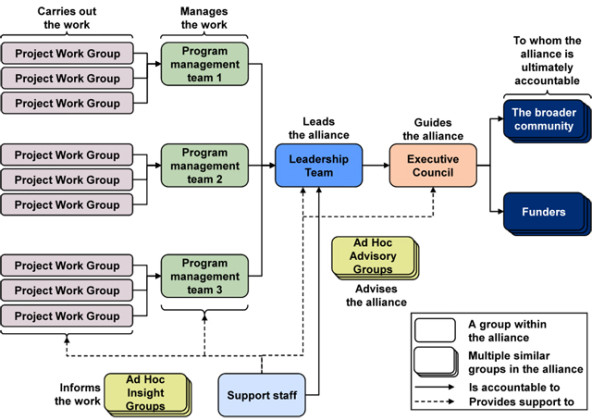Louise Music had a problem. As head of the Alameda County Alliance for Arts Learning Leadership she was watching the demand for the alliance’s services swell. And the alliance couldn’t keep up.
The alliance’s goal was to ensure that every child in Alameda County had art in his or her education. To this end, the alliance helped local groups train teachers, coach parents in advocacy, gather community leaders and educators, and bring artists and arts organizations to classrooms.
Louise, with a handful of paid staff and consultants, coordinated all these activities. Known and respected all over the area, she played a pivotal role in bringing people together and was constantly in demand. Schools wanted more training for their teachers, parents wanted to advocate more, and major foundations were increasing support while expecting more to be done.
But there wasn’t enough of Louise to go around. Being a hub for all the activity had been great when the alliance was small, but now her role was a bottleneck. Maybe it would help to reorganize the alliance as a network, where she wouldn’t need to be at the center of everything. But she wasn’t sure how.
Are you enjoying this article? Read more like this, plus SSIR's full archive of content, when you subscribe.
To help her figure it out, we identified five highly effective multi-organization alliances around the country—networks of many organizations working to implement a set of related programs to achieve a common goal for the community—and set out to determine what made them tick. We investigated Big Thought in Dallas, Nebraska Stars, Chicago Arts Partnership in Education, The National Writing Project, and Oakland Community Organizations.
We anticipated that each alliance would be structured differently. Each was in a different city and was fulfilling different goals. Yet to our surprise, we found that their structures were remarkably similar. In fact, we found the following seven elements in each of the five alliances we studied.
1. An executive council of influential community leaders can deploy human or financial resources, and keeps track of the big picture. It makes sure the alliance focuses on the right areas, monitors progress toward goals, and ensures financial sustainability; it also helps build broad-based support. Executive Council members might include the head of the local community foundation, the mayor, or the superintendent of schools.
2. A leadership team, the hub of the alliance, usually includes point people from each of the key organizations in the alliance. The leadership team determines overall goals and takes responsibility for making sure the alliance accomplishes what it sets out to accomplish. It also invites organizations whose central priorities are in line with the alliance’s goals and are willing to contribute human and financial resources, ensuring that all participants will do their part.
3. Program management teams—made up of managers from key organizations in the alliance—are responsible for one of several broad programs. Each team designs and oversees a set of related projects that together will accomplish the program’s goals.
4. These projects are the engine of a successful multi-organization alliance. Projects must have agreed-upon start dates, end dates, and deliverables, as well as measurable outcomes that demonstrate the project’s success.
5. To implement these projects, program management teams invite people from organizations in the community that are already working on similar projects to form project work groups. These organizations find that the alliance helps them achieve their own goals through increased access to funding, greater visibility, and synergy with like-minded groups. Project work groups meet with the program management teams regularly to evaluate progress against defined objectives, solve problems, and adjust the work to ensure that the projects achieve their goals.
6. Support staff—skilled project managers and coordinators—provide tools and resources to help the alliance accomplish its goals. The staff builds trust within the alliance, liaises between key groups, and mobilizes participants, all to make sure the work moves forward. The staff also manages communications between the alliance and the broader community, ensuring that the community is informed and building support for the alliance’s work.
7. Clear mechanisms for community engagement involve the broader community of stakeholders, both organizations and people. For instance, project work groups might convene focus groups to gain insight and ideas for how to best deliver programs; the executive council might engage advisory groups to discuss how to sustain support. These exchanges ensure that the alliance incorporates a wide variety of voices and ideas, yet also allows them to set appropriate boundaries on the influence of different stakeholders on the alliance’s work.
These elements are related by a structure of accountability.
• The support staff and project work groups are accountable to the program management teams.
• Program management teams are accountable to the leadership team.
• The leadership team is accountable to the executive council.
• The executive council, on behalf of the entire alliance, is accountable to its funders and the broader community it serves.
This accountability structure operates as a positive feedback loop where groups report on their progress, evaluate progress, and jointly make decisions on how to reach the alliance’s ultimate goals.
Using these findings about effective networks, The Alameda County Alliance for Arts Learning Leadership reworked its structure about two years ago, and is very happy with the results. Roles within the alliance are clearer. The sense of purpose among participants has increased dramatically. Participation in the alliance increased from around 20 organizations to almost 75. Important community decision makers are more involved, bringing higher levels of attention and support. All in all, the alliance’s new governance structure has resulted in more art in the education of the students of Alameda County.

The second article in this series shows how the Early Childhood Collaborative in New Britain, Connecticut, used this governance structure to achieve their goals.
Support SSIR’s coverage of cross-sector solutions to global challenges.
Help us further the reach of innovative ideas. Donate today.
Read more stories by John Martin & Christopher Keevil.

